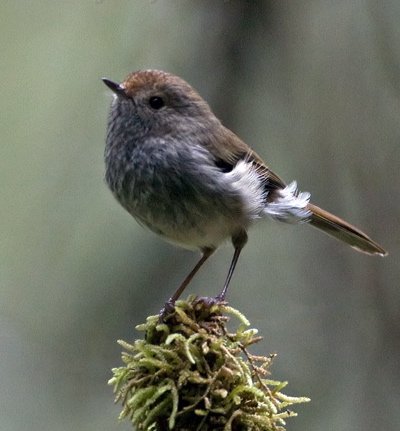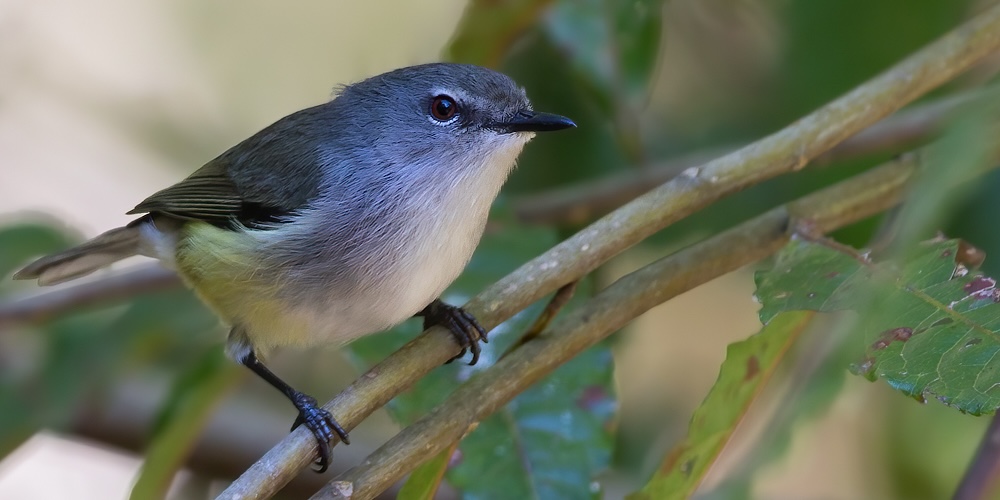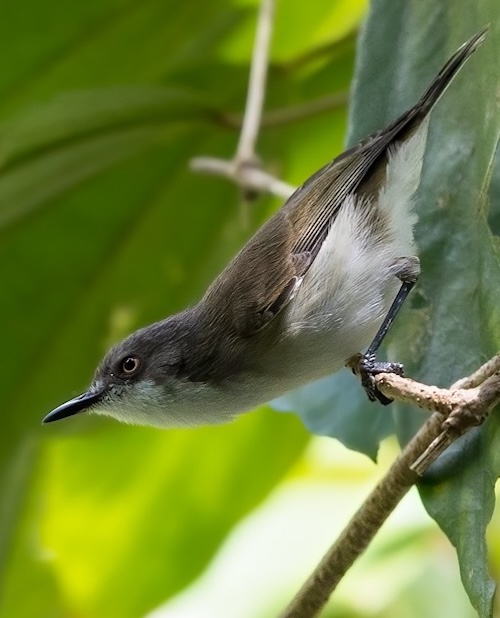Acanthizidae – Australasian Warblers

The Acanthizidae, also known as the Australasian warblers, are a family of passerine birds, which include gerygones, thornbills, and scrubwrens. The Acanthizidae consists of small to medium passerine birds, with a total length varying between 8 and 19 centimetres. They have short rounded wings, slender bills, long legs, and a short tail. Most species have olive, grey, or brown plumage, although some have patches of a brighter yellow. The smallest species of acanthizid, and indeed the smallest Australian passerine, is the Weebill, the largest is the Pilotbird.
Acanthizids are native to Australia, Indonesia, New Zealand, and the south-west Pacific. Most species are found in Australia and New Guinea, with Australia having thirty-five endemic species and New Guinea fifteen. A single species is found in Vanuatu, New Caledonia and the Solomon Islands, and three species occur in the New Zealand region, including endemic species in the Chatham Islands and Norfolk Island. In Asia two species are restricted to Indonesia and another is found in the Philippines and on mainland Asia.
|
|
|
|
Brown-breasted Gerygone Gerygone ruficollis |
Plain Gerygone Gerygone inornata |
|
All photos in this text courtesy of ©Dubi Shapiro |
|
Most species are sedentary, with the exception of the gerygones. The family occupies a range of habitats from rainforests to arid deserts. Most species are terrestrial, feeding primarily on insects, although also eating some seeds. In particular the whitefaces consume large numbers of seeds, and other species will take fruits. The secretions of sap-sucking insects are favoured by some species, as are the insects themselves. Some species are less terrestrial, such as the Weebill, which forages in the treetops, or the rock-dwelling Rockwarbler.

Fan-tailed Gerygone Gerygone flavolateralis
Rainforest species lay one to two eggs in a clutch, and species in the deserts and Tasmania lay three to four. Acanthizids are unusual for passerines in their long incubation periods, which rival those of large songbirds like the Corvidae. Also, despite their long incubation period hatching is completely synchronous and within-brood mortality completely absent.

Large Scrubwren Sericornis nouhuysi
Acanthizids are relatively long-lived, with many species living to over ten years of age in the wild and cooperative breeding is found in the Weebill and with a lesser degree of development in all whitefaces and most species of Sericornis and Acanthiza.
-
Number of bird species: 66
(As at November 2025)
According to the recently (2025) amalgamated AviList, there are sixty-six species, fifteen genera in the Acanthizidae family. They are:
Fernwren Oreoscopus gutturalis
Goldenface Pachycare flavogriseum
Yellow-bellied Gerygone Gerygone chrysogaster
Brown Gerygone Gerygone mouki
Green-backed Gerygone Gerygone chloronota
Fairy Gerygone Gerygone palpebrosa
Large-billed Gerygone Gerygone magnirostris
Biak Gerygone Gerygone hypoxantha
Plain Gerygone Gerygone inornata
Rufous-sided Gerygone Gerygone dorsalis
White-throated Gerygone Gerygone olivacea
Golden-bellied Gerygone Gerygone sulphurea
Dusky Gerygone Gerygone tenebrosa
Fan-tailed Gerygone Gerygone flavolateralis
Rennell Gerygone Gerygone citrina
Mangrove Gerygone Gerygone levigaster
Western Gerygone Gerygone fusca
Brown-breasted Gerygone Gerygone ruficollis
Lord Howe Gerygone Gerygone insularis
Norfolk Gerygone Gerygone modesta
Grey Gerygone Gerygone igata
Chatham Gerygone Gerygone albofrontata
Scrubtit Acanthornis magna
Southern Whiteface Aphelocephala leucopsis
Banded Whiteface Aphelocephala nigricincta
Chestnut-breasted Whiteface Aphelocephala pectoralis
Yellow-rumped Thornbill Acanthiza chrysorrhoa
Grey Thornbill Acanthiza cinerea
New Guinea Thornbill Acanthiza murina
Yellow Thornbill Acanthiza nana
Striated Thornbill Acanthiza lineata
Inland Thornbill Acanthiza apicalis
Tasmanian Thornbill Acanthiza ewingii
Mountain Thornbill Acanthiza katherina
Brown Thornbill Acanthiza pusilla
Slaty-backed Thornbill Acanthiza robustirostris
Slender-billed Thornbill Acanthiza iredalei
Chestnut-rumped Thornbill Acanthiza uropygialis
Western Thornbill Acanthiza inornata
Buff-rumped Thornbill Acanthiza reguloides
Weebill Smicrornis brevirostris
Pilotbird Pycnoptilus floccosus
Speckled Warbler Pyrrholaemus sagittatus
Redthroat Pyrrholaemus brunneus
Chestnut-rumped Heathwren Hylacola pyrrhopygia
Shy Heathwren Hylacola cauta
Striated Fieldwren Calamanthus fuliginosus
Rufous Fieldwren Calamanthus campestris
Western Fieldwren Calamanthus montanellus
Mountain Mouse-warbler Origma robusta
Rusty Mouse-warbler Origma murina
Rockwarbler Origma solitaria
Yellow-throated Scrubwren Neosericornis citreogularis
Pale-billed Scrubwren Aethomyias spilodera
Bicolored Mouse-warbler Aethomyias nigrorufus
Vogelkop Scrubwren Aethomyias rufescens
Buff-faced Scrubwren Aethomyias perspicillatus
Grey-green Scrubwren Aethomyias arfakianus
Papuan Scrubwren Aethomyias papuensis
Tasmanian Scrubwren Sericornis humilis
White-browed Scrubwren Sericornis frontalis
Spotted Scrubwren Sericornis maculatus
Atherton Scrubwren Sericornis keri
Tropical Scrubwren Sericornis beccarii
Large-billed Scrubwren Sericornis magnirostra
Large Scrubwren Sericornis nouhuysi
-
Acanthizidae
Family AccountThe acanthizids are the “little brown jobs” of Australia and New Guinea. Active birds, commonly seen hopping through branches or on the ground in search... -
Acanthizidae
Family AccountAcanthizidae—sometimes called Australian warblers—are a family of passerine birds which includes gerygones, thornbills Acanthiza, and scrubwrens Sericornis...
Given the number of species in this family, Fatbirder does not provide quick links to all of them. However, the entries below do include links to representatives of every genera, all those illustrated and some of the most often encountered, iconic or sought-after species.
-
Brown-breasted Gerygone Gerygone ruficollis
Species AccountA small bird of montane forest edge and villages. Whitish underparts, dark brown back, warmer brown on the head, extending to the sides... -
Brown-breasted Gerygone Gerygone ruficollis
Species AccountSound archive & distribution map -
Chestnut-breasted Whiteface Aphelocephala pectoralis
Species AccountThe chestnut-breasted whiteface (Aphelocephala pectoralis) is a species of bird in the family Acanthizidae. It is endemic to Australia. -
Chestnut-breasted Whiteface Aphelocephala pectoralis
Species AccountSound archive & distribution map -
Fan-tailed Gerygone Gerygone flavolateralis
Species AccountFan-tailed Gerygone Gerygone flavolateralis A small, “cute” gerygone. Has a gray-olive cap with a paler gray throat, a broken white eye-ring... -
Fan-tailed Gerygone Gerygone flavolateralis
Species AccountSound archive & distribution map -
Fernwren Oreoscopus gutturalis
Species AccountThe fernwren (Oreoscopus gutturalis) is a species of bird in the family Acanthizidae. It is monotypic within the genus Oreoscopus. -
Fernwren Oreoscopus gutturalis
Species AccountSound archive & distribution map -
Goldenface Pachycare flavogriseum
Species AccountSound archive & distribution map -
Goldenface Pachycare flavogriseum
Species AccountA small, brightly-colored bird of foothill and lower montane forest canopy. Bright yellow underparts, face and forehead. Gray back and crown. -
Large Scrubwren Sericornis nouhuysi
Species AccountThe large scrubwren (Sericornis nouhuysi) is a bird species. Placed in the family Pardalotidae in the Sibley-Ahlquist taxonomy. -
Large Scrubwren Sericornis nouhuysi
Species AccountSound archive & distribution map -
Papuan Scrubwren Aethomyias papuensis
Species AccountThe Papuan scrubwren (Aethomyias papuensis) is a species of bird in the family Acanthizidae. -
Papuan Scrubwren Aethomyias papuensis
Species AccountSound archive & distribution map -
Pilotbird Pycnoptilus floccosus
Species AccountSmall, chunky bird with a cocked tail, found in wet forested areas and heathland in eastern Victoria and southeastern New South Wales. -
Pilotbird Pycnoptilus floccosus
Species AccountThe pilotbird (Pycnoptilus floccosus) is a species of bird in the Acanthizidae family. It is monotypic within the genus Pycnoptilus. The exact taxonomic placement of this species is disputed, as it bears some resemblance to the bristlebirds. The species is endemic to south-east New South Wales and eastern Victoria in Australia. Its natural habitat is temperate wet sclerophyll forests and occasionally temperate rainforest. There are two subspecies Pycnoptilus floccosus floccosus lives in alpine areas of New South Wales such as the Snowy Mountains and Pycnoptilus floccosus sandfordi lives in lowland forest from Newcastle to Melbourne. -
Pilotbird Pycnoptilus floccosus
Species AccountSound archive & distribution map -
Plain Gerygone Gerygone inornata
Species AccountThe plain gerygone (Gerygone inornata) is a species of bird in the family Acanthizidae. It is found on the islands of Wetar and Timor. -
Plain Gerygone Gerygone inornata
Species AccountSound archive & distribution map -
Redthroat Pyrrholaemus brunneus
Species AccountSmall gray scrubwrenlike bird with a fine bill, usually observed in shrubland, including mulga woodlands. -
Redthroat Pyrrholaemus brunneus
Species AccountSound archive & distribution map -
Rockwarbler Origma solitaria
Species AccountSmall terrestrial bird of Hawkesbury Sandstone region of southern New South Wales. Brown above, reddish brown below, with paler throat... -
Rockwarbler Origma solitaria
Species AccountSound archive & distribution map -
Scrubtit Acanthornis magnus
Species AccountSmall, compact bird with decurved bill found in wet Tasmanian forests. Brown above, pale below, with gray face, olive wash on flanks, and small white wingbar. -
Scrubtit Acanthornis magnus
Species AccountThe scrubtit (Acanthornis magna) is a species of bird in the thornbill family Acanthizidae. It is monotypic within the genus Acanthornis,[2] and is endemic to Tasmania and King Island in Australia. Its natural habitat is the temperate rainforest, Nothofagus beech forest and eucalypt woodland. It is a small species that resembles the Sericornis scrubwrens (with which it was once placed). -
Scrubtit Acanthornis magnus
Species AccountSound archive & distribution map -
Shy Heathwren Hylacola cauta
Species AccountThe shy heathwren (Hylacola cauta) is a species of small bird in the family Acanthizidae, endemic to Australia. -
Shy Heathwren Hylacola cauta
Species AccountSound archive & distribution map -
Striated Fieldwren Calamanthus fuliginosus
Species AccountSound archive & distribution map -
Striated Fieldwren Calamanthus fuliginosus
Species AccountSmall bird with heavy streaking and long cocked tail. -
Tasmanian Thornbill Acanthiza ewingii
Species AccountThe Tasmanian Thornbill is a medium sized thornbill very similar to the Brown Thornbill A. pusilla. The two are best told apart by the adage that the Tasmanian Thornbill "wears the white underpants". The adult Tasmanian Thornbill is olive-brown above with rufous-brown suffusion to the forehead; dull rufous-brown rump-patch and prominent rufous brown panel on folded wings. The underparts are off-white with diffuse fine dusky mottling on chin, throat and breast, and clean white undertail-coverts. Juvenile birds are similar to adults but newly fledged birds are fluffier. -
Tasmanian Thornbill Acanthiza ewingii
Species AccountThe Tasmanian thornbill (Acanthiza ewingii) is a small brown bird only found in Tasmania and the islands in the Bass Strait. -
Tasmanian Thornbill Acanthiza ewingii
Species AccountSound archive & distribution map -
Weebill Smicrornis brevirostris
Species AccountThe weebill (Smicrornis brevirostris) is Australia's smallest bird at approximately 8 to 9 cm (3.1 to 3.5 in) long. It is an olive-yellow songbird with a grey bill, brown wings, pale yellow eyes and grey feet. Its tail feathers are brown with a black bar and white spot on the tip of all inner webs but the central pairs. The sexes are similar. The weebill is the only member of genus Smicrornis; gene flow is strong and local variation follows Bergmann's and Gloger's Rules. -
Weebill Smicrornis brevirostris
Species AccountThe Weebill's common name comes from the short, stubby, pale beak. The eye is pale cream, and there is a pale line above the eye. Weebills are dull grey-brown on the head and olive-brown on the back, and the underparts are buff to yellow. In the south and east of the country, the birds are light brown, while northwards and inland they become paler and more yellow. Both sexes are similar in colouration, and young birds can be separated from the adults by their greyer eye. -
Weebill Smicrornis brevirostris
Species AccountSound archive & distribution map -
Yellow-throated Scrubwren Neosericornis citreogularis
Species AccountThe yellow-throated scrubwren (Neosericornis citreogularis) is a passerine in the family Acanthizidae that is found in parts of eastern coastal Australia. -
Yellow-throated Scrubwren Neosericornis citreogularis
Species AccountSound archive & distribution map


